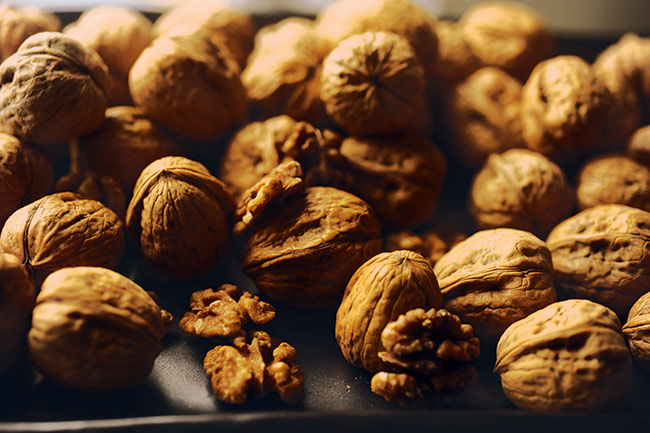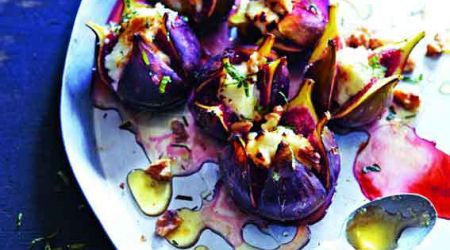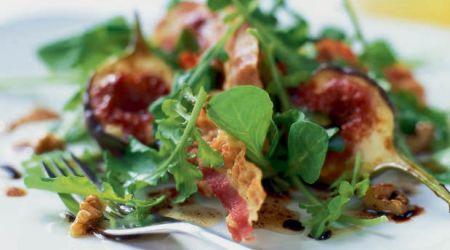Walnuts
Imparting texture, depth and nutritional goodness to a range of ingredients, the creamy white nut is a festive season staple, says Helen Hokin with recipes by Linda Tubby
Not since the Victorian era has the noble walnut orchard graced the English countryside. The grid-shaped layout of robust, thick-branched trees was once a familiar feature on the south-east’s landscape and in many kitchen gardens. Their popularity at the time is reflected in the number of recipes written for them: coffee and walnut layer cake, sugar plums and steamed puddings all called for freshly cracked English walnuts. The Victorians were great believers in preserving and baking in preparation for Christmas, but no other festive dish was set in motion earlier then the pickled walnut. The unripe, green fruit was gathered in June, suspended in vinegar and spices and squirreled away until winter festivities began. For perking up cold cuts on Boxing Day it was, and still is, the preserve of choice.
Sadly, most of the walnuts we eat today are imported from North America – quality is often poor and they can arrive old, dry and chemically cleaned – and mainland Europe, where they are still grown as much for domestic as commercial use. When the fruit ripens in autumn it provides one of the most protein-dense harvests available to man. A ten-year-old tree yields an average of ten kilos of nuts a year – to be pickled, pressed into oil, ground into flour, pasta sauces, soups and, of course, paired with cheese.
It’s believed that England’s cooler 20th-century climate sounded the death knell for the domestic walnut industry. But the good news is that, despite the washout of a summer we had this year, global warming over the last decade has improved growing conditions and the century-long lull is at an end. Farmers are planting up again and slowly but surely, from Sussex to Somerset and up to East Anglia, growers are reporting better harvests year on year; the late frost, once so harmful to the ripening fruit, seems all but a distant memory. Our pickling tradition is enjoying something of a renaissance, too. Sittingbourne-based walnut pickler, William Opie, uses all the English walnuts he can get his hands on although, to fill upwards of 75,000 jars a year, he understandably turns to foreign imports as well.
After the first summer gathering of still green walnuts, for use in pickles in England and noccino in Italy (a spicy liqueur made with the unripe fruit and husk), the main harvest of fully ripened nuts begins around the end of September; farmers judge their readiness by watching for the first husks to split. By November they are in the shops – if you’re lucky enough to find English walnuts they will probably be the Broadview variety but, in their absence, there are a number of European lovelies. Plovdivski and Proslavski from Bulgaria deliver creamy texture and good nutty flavour in equal quantities while French classics, Rita, Lara and Franquette, are small and subtle, and considered by many as superior to the rest.
Most importantly, however, is to always seek out freshness over variety. Walnuts deteriorate rapidly, turning rancid with age and taking on an unpleasant woody, mustiness once they’re past their best. Buy the freshest nuts you can find and store them in the fridge in a sealed container. Shell-on nuts should feel heavier than they look and have a shiny finish. Avoid dull, cracked shells or those with a hollow sounding rattle. Ready shelled, they should be plump and even-coloured. Remember to remove the bitter skin from older nuts by standing them in hot water for ten minutes, then drying them vigorously with a tea towel. A light toasting will enhance their flavour but keep an eye on them – they turn from golden to smoking in seconds.
Walnuts add interest and crunch to cakes, desserts and baklava. In south-west France, where they grow in abundance, they are the star ingredient in a time-honoured, velvety walnut soup. Across the Mediterranean their delicate oil adds gloss and aroma to salads and is perfect for dressings and drizzling. It doesn’t keep well so store it in the fridge and use within three weeks. The protein-packed nut marries beautifully with apples and pears, celery, dates, figs and cheese. Crack a few open and pair them with shards of hard goats’ cheese for an instant and delicious supper. Serve a handful of pickled walnuts with a slice of cold ham, or enjoy a wedge of date and walnut cake, moist with fruit and spices and as dark as the solstice. Winter’s not all bad.

Recipes
Get Premium access to all the latest content online
Subscribe and view full print editions online... Subscribe



